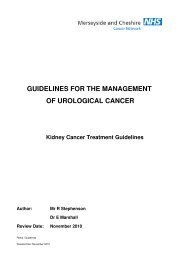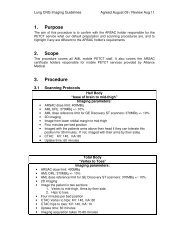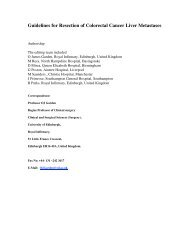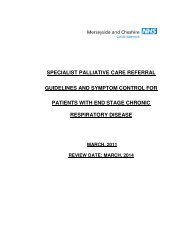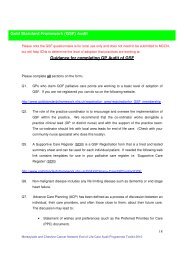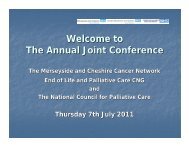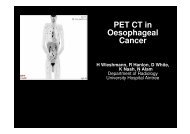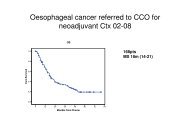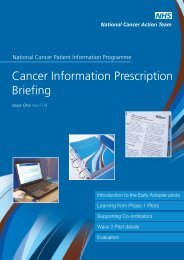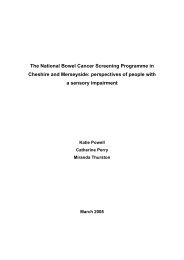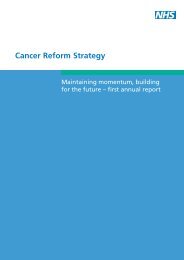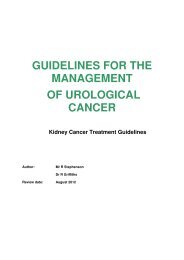Cancer Reform Strategy - NHS Cancer Screening Programmes
Cancer Reform Strategy - NHS Cancer Screening Programmes
Cancer Reform Strategy - NHS Cancer Screening Programmes
- No tags were found...
Create successful ePaper yourself
Turn your PDF publications into a flip-book with our unique Google optimized e-Paper software.
CHAPTER 4: ENSURING BETTER TREATMENT 63technology appraisals. Thirty nine of theseappraisals have partly or fully recommended theuse of the treatment in the <strong>NHS</strong>. The 44appraisals relate to 23 different cancer drugs,some of which have been appraised for morethan one indication (use).4.38 In line with this, expenditure on anticancerdrugs has increased as indicated by Figure 8 (onprevious page).4.39 In total, approximately £729m was spentin 2006 on drug treatment for cancer. Thefastest growth relates to the more newlylicensed anticancer drugs which have beenapproved by NICE. Over an 18 month periodbetween 2003 and 2005, the median rate ofusage for 14 anticancer drugs approved by NICEincreased by 47 percent.4.40 However, despite this several problemswith access to drug treatments for cancer havebeen identified on which action is needed:●●●●Local decisions where NICE guidance is notavailable;Time lags before NICE makes its appraisaldecision;Variable use of NICE-approved drugs acrossthe country;Poor local planning for chemotherapyservices in some areas; andthis strategy has been developed and agree theyneed to be addressed.4.43 When NICE guidance is not yet available, itis for PCTs to determine whether or not to funda drug locally should they receive a request froma doctor/patient for its use. They have to basetheir decision on an assessment of the availableevidence, the circumstances of the patientrequiring the treatment and the health needs oftheir local population. It is not acceptable for aPCT to use a lack of NICE guidance as a reasonto reject an application for a drug. This wasemphasised by the Department in December2006 in the document ‘Good Practice Guidanceon Managing the introduction of NewHealthcare Interventions and Links to NICETechnology Appraisal Guidance’ which updatedand clarified the messages contained in HealthService Circular 1999/176.4.44 The updated advice also notes that thereare a number of valuable sources of informationavailable to the <strong>NHS</strong>, which can help in makingdecisions about the use of new treatmentswhere NICE guidance is not available. Most ofthese sources are available online and includesummaries of the available evidence on thesafety and effectiveness of new treatments. Thegood practice guidance makes clear that thesesources can help local <strong>NHS</strong> organisations makemore informed decisions. PCTs could choose towork together on these decisions, for exampleacross an SHA area. Information sources ofparticular relevance to cancer drugs are:●Ensuring patient safety.4.41 One of the issues that has been raised bysome stakeholders leading up to this strategy isthe issue of pricing of cancer drugs. The widerissue of pricing of drugs is being dealt withseparately by the Department of Health and istherefore not addressed in this document.Local decisions where NICEguidance is not available4.42 There remain concerns about the processprior to drugs being referred to NICE and alsoduring the period where NICE is consideringdrugs. We have listened to these concerns as●●London <strong>Cancer</strong> New Drugs Group whichdevelops recommendations for the managedentry of new treatments in cancer acrossLondon. Its recommendations can be foundon the National Electronic Library forMedicines website (seewww.druginfozone.nhs.uk);National Prescribing Centre (NPC) NewMedicines Scheme which provides a range ofevaluated information, both pre-and postmarketlaunch, on new medicines (seewww.npc.nhs.uk); and




